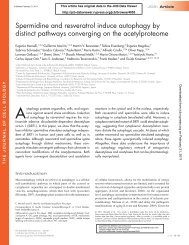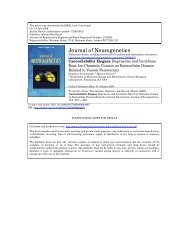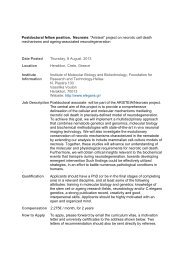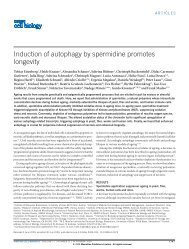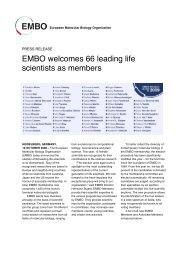CELL BIOLOGY OF THE NEURON Polarity ... - Tavernarakis Lab
CELL BIOLOGY OF THE NEURON Polarity ... - Tavernarakis Lab
CELL BIOLOGY OF THE NEURON Polarity ... - Tavernarakis Lab
Create successful ePaper yourself
Turn your PDF publications into a flip-book with our unique Google optimized e-Paper software.
Cell Biology of the Neuron: <strong>Polarity</strong>, Plasticity and Regeneration, Crete 2011<br />
Linking Synaptic Endocytosis to Retrograde Axonal<br />
Transport: the Role of the Coxsackievirus and<br />
Adenovirus Receptor in Neuronal Trafficking of<br />
Adenoviruses<br />
Sara Salinas 1 , Charleine Zussy 1 , Daniel Henaff 1 , Neus Bayo-Puxan 1 ,<br />
Giampietro Schiavo 2 , Eric Kremer 1<br />
1 Institut de Génétique Moléculaire de Montpellier-CNRS<br />
2 Molecular NeuroPathobiology <strong>Lab</strong>oratory, Cancer Research UK, London<br />
Research Institute, London, United Kingdom,<br />
The coxsackievirus and adenovirus receptor (CAR) is an adhesion molecule and a<br />
key component of tight junctions in epithelia. Its role as adenovirus receptor was<br />
mainly described as a docking factor in the first step of membrane binding with<br />
no subsequent role in the internalisation process. This molecule is also largely<br />
expressed in the nervous system but its function in neurons remains<br />
uncharacterised. Axonal transport is responsible for the movement of cargoes<br />
between nerve termini and cell bodies of neurons and can be diverted by<br />
pathogens to reach the central nervous system (CNS). Here, we characterised the<br />
axonal traffic of an adenovirus (CAV-2) that preferentially infects neurons. In<br />
addition to its relevance to disorders associated with adenovirus infections of the<br />
CNS, the potential use of adenoviral vectors to treat brain pathologies makes the<br />
understanding of their neuronal trafficking crucial. We show that CAV-2 displays<br />
bidirectional motility in axons of motor neurons and, in contrast to adenovirus<br />
trafficking in epithelial cells, its transport occurs in Rab7+ pH neutral vesicles.<br />
CAV-2 binding is CAR-dependent and, unexpectedly, CAR is found associated<br />
with axonal vesicles containing CAV-2 and a variety of cargoes such as tetanus<br />
toxin and neurotrophin receptors. These observations suggest that some axonal<br />
Rab7 organelles provide a protective environment for endogenous molecules and<br />
pathogens to be transported over long-distances. Finally, sub-cellular localisation<br />
studies showed that a portion of CAR is localised to the pre-synaptic part of<br />
central synapses and neuromuscular junctions, raising a potential role of this<br />
adhesion molecule during synaptogenesis or for synaptic stability<br />
Presented by: Salinas, Sara<br />
Poster No 096<br />
Blue Session<br />
178



